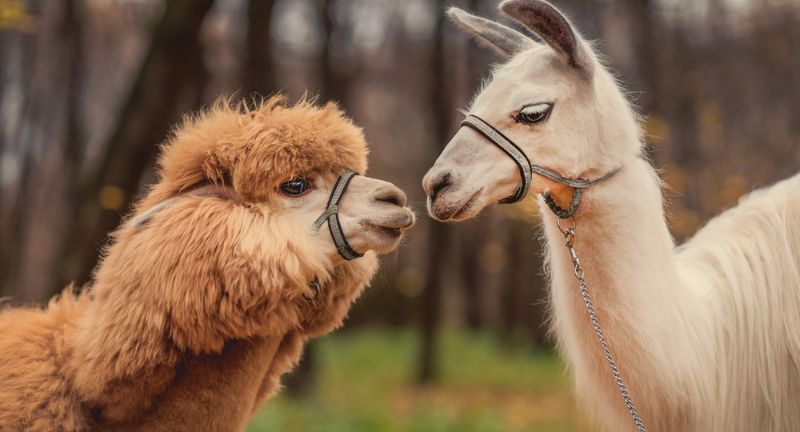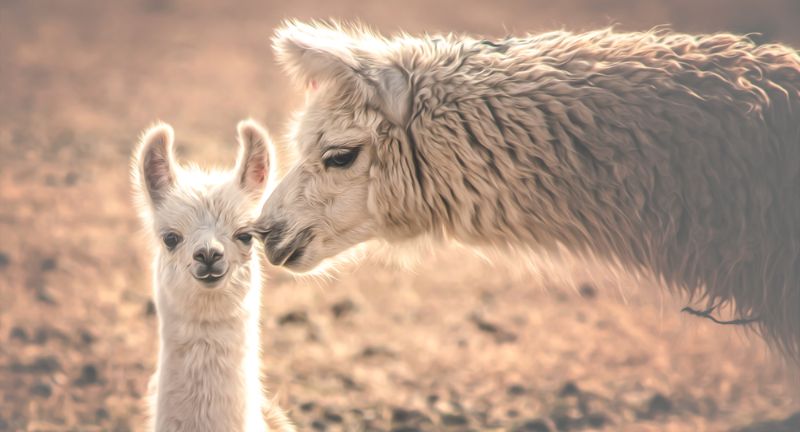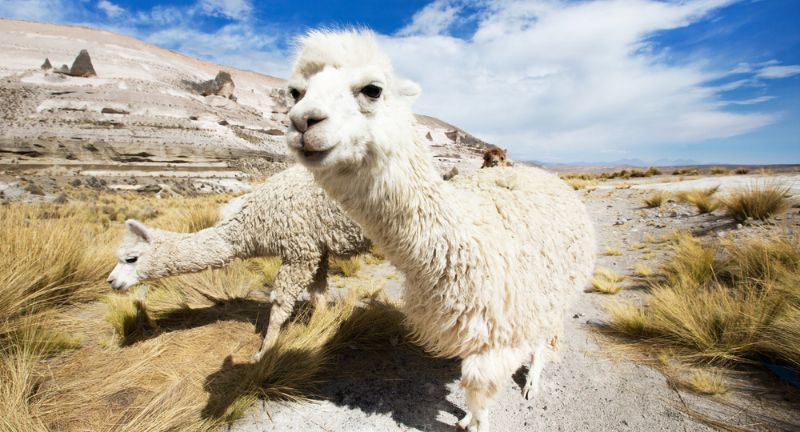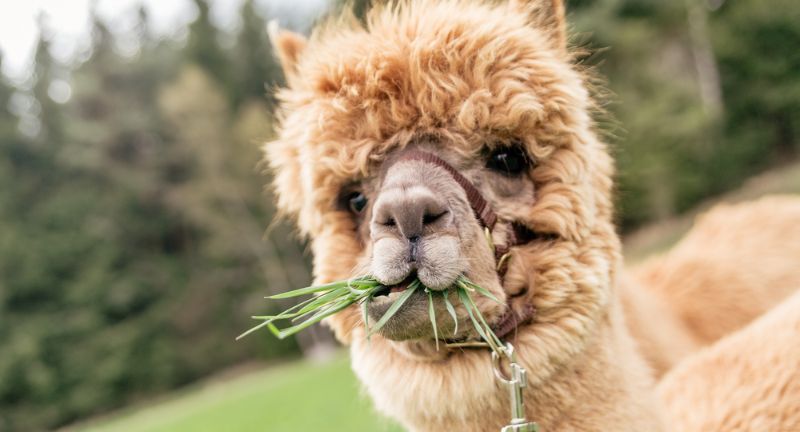ANIMALS
20 Amazing Facts About Alpacas and Llamas
Published
7 months agoon

Shutterstock
Llamas and alpacas, two captivating creatures from South America, have charmed people worldwide with their unique characteristics and endearing behaviors. These gentle and intelligent animals, domesticated thousands of years ago by the indigenous people of the Andes, play essential roles in various aspects of life, from wool production to therapy. Their fascinating habits, social structures, and eco-friendly nature make them a popular choice for farmers and animal enthusiasts alike. In this exploration, we’ll delve into 20 amazing facts about llamas and alpacas, uncovering what makes these animals so special. Join us as we embark on a journey through the world of these remarkable creatures.
Ancient Companions

Shutterstock
Both llamas and alpacas were domesticated over 5,000 years ago by the indigenous people of the Andes. These animals played a crucial role in the development of Andean civilizations, serving as essential resources for transportation, food, and clothing. Their domestication allowed for the establishment of trade routes and agricultural practices in harsh environments. The relationship between these animals and humans is a testament to their significance in ancient cultures.
Distinct Species

Shutterstock
Although often confused, llamas and alpacas are distinct species with different physical and behavioral characteristics. Llamas are larger and primarily used as pack animals, known for their strength and endurance. In contrast, alpacas are smaller and highly valued for their fine, soft wool, which is used in high-quality textiles. These differences highlight the unique roles each animal plays in their native environments.
Height and Weight

Shutterstock
Llamas stand about 5.5 to 6 feet tall at the head and weigh between 280 to 450 pounds, making them much larger than alpacas. Alpacas are shorter, standing about 3 feet tall at the shoulder, and weigh between 100 to 200 pounds. These size differences reflect their distinct purposes, with llamas being more suited for carrying loads and alpacas for producing wool. Their varying sizes also influence their care and handling requirements.
Wool Wonders

Shutterstock
Alpaca wool is highly prized for its softness, warmth, and hypoallergenic properties, making it a popular choice for luxury garments. It is available in 22 natural colors, more than any other fiber-producing animal, which adds to its desirability among artisans and fashion designers. The wool is not only soft but also durable and lightweight, providing excellent insulation. This combination of features makes alpaca wool a superior material for a variety of textiles.
Two Alpaca Breeds

Shutterstock
There are two breeds of alpacas: Huacaya and Suri, each with distinct fleece characteristics. Huacayas have fluffy, crimped fleece that is dense and springy, making it ideal for soft, warm garments. Suris, on the other hand, have long, silky locks that hang down in elegant strands, prized for their luster and smooth texture. These differences in fleece type offer a range of options for textile production, catering to various aesthetic and functional preferences.
Herd Animals

Shutterstock
Both llamas and alpacas are social creatures that thrive in herds, relying on group dynamics for safety and social interaction. They communicate with each other through a series of ear, tail, and body postures, as well as vocalizations like humming. This complex communication system helps maintain order and cohesion within the herd. Their social nature also means they can become stressed or lonely if isolated from their companions.
Gentle Disposition

Shutterstock
Llamas and alpacas are known for their gentle and curious nature, making them popular among animal enthusiasts and farmers alike. They are typically docile and approachable, although they can also be quite protective of their herd. This protective behavior includes alerting others to potential dangers and, in the case of llamas, even confronting predators. Their endearing personalities and manageable size make them suitable for various human-animal interactions, including therapy.
Unique Communication

Shutterstock
These animals hum to communicate, a behavior that is both unique and endearing. A mother might hum to her cria (baby) as a form of bonding, while herd members hum to express contentment or stress. This vocalization serves as a way to maintain social bonds and convey emotions within the group. Humming is just one of the many ways llamas and alpacas interact with each other, showcasing their complex social behaviors.
Spitting

Shutterstock
Llamas and alpacas spit as a defense mechanism, primarily to establish dominance within the herd or when they feel threatened. This behavior involves ejecting a mixture of partially digested food and stomach acid, which can be quite unpleasant for the recipient. Spitting is also a way for them to communicate displeasure or irritation, particularly during disputes over food or territory. Despite this behavior, they are generally gentle animals that reserve spitting for specific situations.
Efficient Digesters

Shutterstock
Both animals have a three-compartment stomach, allowing them to efficiently process tough Andean vegetation. This adaptation is essential for their survival in the high-altitude, nutrient-poor environments of the Andes. Their digestive system extracts maximum nutrients from minimal food sources, making them well-suited to harsh climates. This efficiency also means they have lower feeding requirements compared to other livestock, which is beneficial for sustainable farming.
Intelligent and Trainable

Shutterstock
Llamas and alpacas are highly intelligent and can be trained for various tasks, showcasing their adaptability and usefulness. Llamas, in particular, are often used as pack animals and can carry loads up to 25% of their body weight, making them valuable for transportation in rugged terrains. Their trainability also extends to participating in shows and therapy programs, where they interact positively with people. This intelligence makes them versatile animals capable of learning and performing complex behaviors.
Eco-Friendly Grazers

Shutterstock
Their padded feet are gentle on the terrain, and they graze without uprooting plants, making them environmentally friendly animals. This grazing behavior helps preserve the ecosystem by maintaining plant growth and preventing soil erosion. Additionally, their low-impact grazing is beneficial for sustainable farming practices, as it reduces the need for land restoration. This eco-friendly nature makes llamas and alpacas a preferred choice for environmentally conscious farmers and conservationists.
Crias

Shutterstock
Baby llamas and alpacas are called crias, and their birth is a significant event within the herd. They are born after an 11 to 12-month gestation period and can stand and walk within an hour of birth, displaying remarkable early mobility. This quick adaptation to mobility is crucial for their survival in the wild, where they need to be able to follow the herd and evade predators. The birth of a cria is a joyous occasion and signifies the continuation of the herd’s lineage.
Versatile Uses

Shutterstock
Beyond wool production, alpacas are raised for their meat in South America, providing a valuable source of protein. Llamas are also used as guard animals, protecting livestock like sheep from predators, thanks to their alert nature and protective instincts. Their versatility extends to being companions and working animals, contributing to various aspects of human life. This wide range of uses highlights their importance in agricultural and rural communities.
Ancient Symbols

Shutterstock
In Incan culture, llamas were revered and often depicted in art and textiles, symbolizing wealth and prosperity. They were used in religious ceremonies and as sacrificial animals to appease the gods, highlighting their spiritual significance. The Incas also relied on llamas for transportation and wool, integrating them deeply into their daily lives. This cultural reverence underscores the historical and symbolic importance of llamas in Andean societies.
Therapy Animals

Shutterstock
Due to their gentle nature, llamas and alpacas are increasingly used in animal-assisted therapy programs, providing comfort and companionship to people in hospitals and nursing homes. Their calm demeanor and approachable size make them ideal therapy animals, capable of forming strong bonds with humans. These interactions can significantly improve mental health and emotional well-being, offering therapeutic benefits. The use of llamas and alpacas in therapy showcases their potential to enhance human lives in meaningful ways.
Clean and Odorless

Shutterstock
Both llamas and alpacas are naturally clean animals that use communal dung piles, which helps control parasites and maintain a tidy living environment. Their fleece is lanolin-free, meaning it doesn’t have a strong odor and is easier to process. This clean and odorless quality makes them more pleasant to manage compared to other livestock. Their hygienic habits contribute to their appeal as farm and companion animals.
Guardians

Shutterstock
Llamas make excellent guard animals for flocks of sheep or goats, as they are naturally alert and will confront and chase away potential predators. This protective instinct makes them valuable for farmers looking to safeguard their livestock without the use of aggressive guard dogs. Their presence can deter predators like coyotes, providing an additional layer of security for the herd. This guardian role underscores their versatility and usefulness in agricultural settings.
Low-Maintenance

Shutterstock
Llamas and alpacas are hardy animals that require minimal medical care and can adapt to various climates, making them relatively low-maintenance compared to other livestock. Their efficient digestive systems mean they need less food, reducing feeding costs and resource use. They also have a strong resistance to common diseases, which decreases the need for frequent veterinary visits. This low-maintenance nature makes them an attractive option for farmers and hobbyists alike.
Global Popularity

Shutterstock
Today, llamas and alpacas are found worldwide, cherished for their unique personalities, valuable fleece, and contributions to sustainable farming practices. Their adaptability has allowed them to thrive in diverse environments, from North America to Europe and beyond. This global popularity reflects their versatility and the growing appreciation for their many benefits. As more people discover the joys of raising llamas and alpacas, their role in agriculture and therapy continues to expand.
Conclusion

Shutterstock
Llamas and alpacas are truly remarkable animals, each with their unique contributions to human society and the environment. Their rich history, gentle nature, and versatile uses make them invaluable companions in both traditional and modern settings. From their prized wool to their roles in therapy and farming, these animals continue to enhance our lives in countless ways. Understanding and appreciating their many fascinating qualities helps us forge a deeper connection with these beloved creatures. As we continue to learn more about llamas and alpacas, their legacy as cherished members of the animal kingdom will undoubtedly endure.
More Amazing Animals+
-


Why We Love Penguins
-


Vitakraft’s Squeezable, Hand-Fed Snacks Named Best Cat Treat of 2022
-


More – Orphaned bear cubs playing in tree and post-rescue…
-


These super-awesome #fire #goats are stoked to get new plants…
-


30 Most Unusual Rainforest Animals
-


The most beautiful thing you will watch today. Great #Hornbill…
-


The Truth About Storks and Baby Deliveries
-


A Woman Recieves a Surprise Gift in the Air After…
-


What Makes Anglerfish And Frogfish So Unique?
-


25 Facts About Monarch Butterflies And Their Remarkable Migration Journey
-


20 Rabbit Breeds That Are Just As Unique As They…
-


25 Birds That Migrate For Winter
